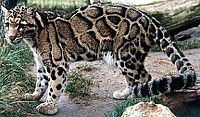
Photo from wikipedia
In this study, we present the first data concerning the anatomical, morphometrical, histological and histochemical study of the orbit, eye tunics, eyelids and orbital glands in South African Painted Dogs… Click to show full abstract
In this study, we present the first data concerning the anatomical, morphometrical, histological and histochemical study of the orbit, eye tunics, eyelids and orbital glands in South African Painted Dogs (Lycaon pictus pictus). The study was performed using eyeball morphometry, analysis of the bony orbit including its morphometry, macroscopic study, morphometry, histological examination of the eye tunics and chosen accessory organs of the eye and histochemical analysis. The orbit was funnel shaped and was open-type. There was a single ethmoid opening for the ethmoid nerve on the orbital lamina. The pupil was round, while the ciliary body occupied a relatively wide zone. The iris was brown and retina had a pigmented area. The cellular tapetum lucidum was semi-circular and milky and was composed of 14–17 layers of tapetal cells arranged in a bricklike structure. In the lower eyelid, there was a single conjunctival lymph nodule aggregate. One or two additional large conjunctval folds were observed within the posterior surface of the upper eyelids. The superficial gland of the third eyelid had a serous nature. The third eyelid was T-shaped and was composed of hyaline tissue. Two to three conjunctival lymph nodul aggregates were present within the bulbar conjunctiva of the third eyelid. The lacrimal gland produced a sero-mucous secretion. A detailed anatomic analysis of the eye area in the captive South African Painted Dogs females showed the similarities (especially in the histological examination of the eyetunics and orbital glands) as well as the differences between the Painted dog and the other representatives of Canidae. The differences included the shape and size od the orbita with comparison to the domestic dog. Such differences in the orbit measurements are most likely associated with the skull type, which are defined in relation to domestic dogs. The presented results significantly expand the existing knowledge on comparative anatomy in the orbit, eye and chosen accessory organs in wild Canidae.
Journal Title: PLoS ONE
Year Published: 2021
Link to full text (if available)
Share on Social Media: Sign Up to like & get
recommendations!